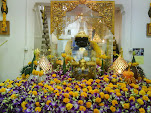In the early period, the Rahu belief was first represented symbolically in the amulet form. This sacred object, owed to the local belief in its spiritual power, served the community to establish its solidarity and allowed it to pursue several social and economic crises, i.e. side effects of the war between Siam and Laos during the Thonburi and early Rattanakosin periods, the strict regulations of the siam government, and the physical environment of the community which was hard for living.
In the revival time, the production of Rahu amulet was promoted under the economic pressure as community needed resources for renovating the temple and establishing the elementary school. Its claimed spiritual power also suited the psychological need of middle class people during the dramatic social and economic changes in the period from 6th to the 8th reigns.
Finally, during the globalization era, the Rahu tradition of Wat Srisathong has again been reinvented under the discourse to suit the wide belief of the Rahu God promoted via various forms of media in the Thai social sphere. The tradition of Rahu at Wat Srisathong; however, claimed for its authenticity and originality in contrast to the Rahu believes and traditions at other places.
The study illustrated that the Rahu “invented tradition” of Wat Srisathong had changing meaning and function parallel to the social and cultural changes of the community.
胡


No comments:
Post a Comment